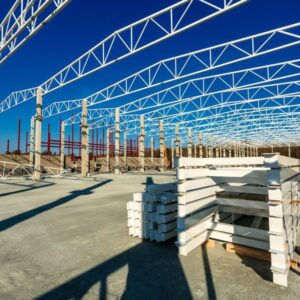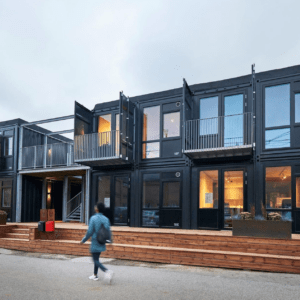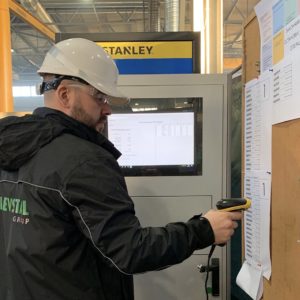The definition of steel column
Steel as a material in the construction industry has quickly become one of the most important materials for the overwhelming majority of projects all over the world. Steel allows for construction projects to be even more creative and unusual than ever before. However, a lot of these projects may require a number of supporting structures to ensure that the structure itself can stay the way it needs to stay.
A supporting structure’s definition is exactly what you can discern from its name – it is a structure that supports the building or some sort of construction project, with the steel column being one of the biggest examples. A steel column is one of the many vertical structure elements that can be used to provide essential support to all kinds of buildings.
It is possible for steel columns to transfer loads from different elements of a building (roof slabs, ceilings, beams, and so on), and they can also carry loads via compression. Another use case for metal columns is to carry bending elements in specific structure parts.
Since steel columns can be applied to many different project types, it is only natural for steel columns to also have a lot of variation when it comes to classifying metal columns using specific conditions. Here are some examples of that classification:
- Different shapes of a column;
- Different slenderness ratio of a column;
- Different cross section type in a column;
- Different lateral load resistivity in a column;
- Different construction material variation;
- Different height of a column;
- Different weight spread of a column;
- Columns that do not belong to any of the popular classification types.
Steel column types
We can also mention several specific steel column types that are considered the most common or the most important for the industry as a whole. In the following list we are going to go over ten different steel column types:
- Composite steel columns;
- Short reinforced steel columns;
- Square/rectangular steel columns;
- Tension steel columns;
- T-shaped steel columns;
- Circular steel columns;
- L-shaped steel columns;
- Spiral steel columns reinforced with concrete;
- Stub steel columns;
- Tied steel columns reinforced with concrete.
Composite steel column
Composite steel columns are extremely versatile in terms of providing reinforcement since each composite column consists of not only structural steel, but also concrete and additional reinforcement. These columns provide longitudinal reinforcement, offer an extremely high capacity in terms of how much they can support, which makes them valuable for specific project types, such as high-rise buildings. Composite steel columns can also offer a high level of strength within a single cross-section and have a higher than average fire resistance.
Short reinforced steel column
This particular term includes a number of steel columns that differ depending on how slender they are – with less than 12 inches of thickness. Despite the fact that each column contains a steel bar within itself, these columns have a surprising amount of flexibility, which makes them useful for a variety of projects with different purposes.
Square/rectangular steel column
As the name suggests, this category involves two different groups of columns based on their shape – either square or rectangular. Each column of this type includes four or more vertical steel beams for support purposes. As such, it is an affordable option for several different purposes, such as concrete pouring, shuttering or reinforcement placing.
Tension steel column
Now this, on the other hand, is a column type that differs based on their peak loading capabilities. Tension columns can be made of concrete, steel, and several other material types – but that does not make it a popular column type. As such, tension columns have a rather narrow set of use cases where they are actually used in projects, such as bridge construction or creation of bigger foundation-based columns for larger projects.
T-shaped steel column
One of the easiest column types to discern, since its name comes from its shape. This is another example of a column type that is mostly used for bridge construction purposes, as well as some other specific goals.
Circular steel column
Another example of a column type based on its shape – circular steel columns have a specific circular shape and include a reinforcement bar that consists of at least four longitudinal steel bars. Circular steel columns tend to offer higher than average bending resistance and are commonly used for the purpose of elevating and piling buildings, or as regular bridge pillars for supporting purposes.
L-shaped steel column
Of course, the entire construction industry would not be satisfied with using only T-shaped columns and elements, which is why there are far more of these shapes in classification. L-shape is one such example, and this particular type combines the ease of construction with its supporting capabilities, making an L-shaped column a must-have for a lot of different building types – and construction projects tend to use these columns in places such as corners of boundary walls quite a lot.
Spiral steel column reinforced with concrete
This column type uses both concrete reinforcement and steel reinforcement via embedding a steel mesh (rebar) into the column’s structure. All of these columns are cylindrical in shape and each of them has a continuous helical bar that wraps itself around the column, providing transverse support for the entire structure as a whole.
Stub steel column
The main distinctive parameter of these columns is their height – since stubs are usually placed on slabs, they have to be shorter than your average steel column. They can be used either horizontally or vertically for additional support, and can be created using either steel or concrete. A popular example of a stub steel column is under overhead water tanks.
Tied steel column reinforced with concrete
Tied reinforced steel columns are structured in a similar fashion to other reinforced column types (such as spiral) since it also has a foundation in the form of an embedded mesh that is surrounded by concrete. However, this particular type also uses lateral ties between different columns to provide more structural support. There is a great deal of accuracy involved here, since ties themselves have to be close enough to provide support to the structure but also far enough for them to not affect how the concrete sets.
10 steel column ideas
Since it is fairly common for steel columns to be used in buildings of all shapes and sizes, there are many examples of steel columns being used as both a supporting structure and an element of the overall design. However, figuring out a new and unique design for a steel column can be surprisingly problematic since steel allows for a lot of creative freedom in the first place.
To help people with this particular problem we have collected ten different ideas of a steel column design that may be used in many different cases, from your classical bridges and walkways to massive parts of a rooftop. These examples are not placed in an ascending or descending order, the number count exists solely for the purpose of making the overall viewing experience more convenient.
- A column of wood and steel

Our first example is a fairly small one by the steel column standards – it is a supporting structure that uses a singular steel column as the first half of the structure and divides it into two identical parts starting from the middle of the column. It is a great artistic object that uses a combination of steel and wood to provide both structural support and to add to the overall design of the structure in question.
- Massive supporting steel column

Since this kind of branching shape of a steel column allows for it to cover far more area compared with its traditional shape, there are quite a lot of different examples that use a similar idea – using a single steel column that branches out into multiple smaller shapes to support a wide surface of sorts, such as a roof or an entire floor. You can see how this example uses a rather unconventional shape of a column, with the upper parts of it looking like thick sheets of metal rather than your classic relatively even steel column shape.
- Tree-like column structure
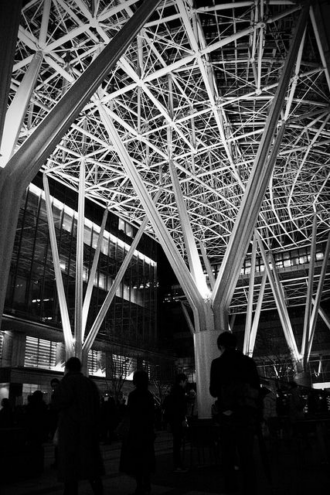
Expanding the previous idea even more, this example shows us multiple similar steel columns that devolve into several different “branches” each, creating the overall shape of the supporting structure that looks extremely similar to how a regular tree with no leaves would look like. The overall simplistic color scheme of the structure’s interior combined with the lighting makes this particular example even more visually impressive while also being a functional set of steel columns.
- Basic steel column
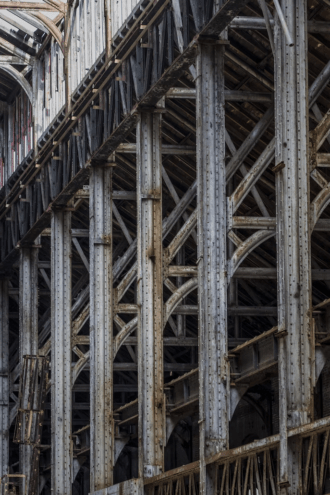
While it is true that steel columns offer a lot of freedom when it comes to different styles and ideas in design, it would be also fair to mention examples of how your most bog-standard steel columns look like. In fact, a lot of people see these kinds of structures on a regular basis and rarely pay them any mind, since they tend to blend in with the environment so well. The same idea applies to this steel column example, which is just a long metal object that is used to support an extremely heavy structure. Columns like these tend to be affected by harsh weather conditions quite a lot, which is where all the rust comes from
- Doubled supporting steel column

The base of a steel column does not have to be one single piece of steel or concrete, either. Here is an example of a steel column that uses four different steel rods to support an overhead structure. The unique part of this structure is that each pair of steel rods is connected to each other, making it far more unusual for the naked eye while also improving its supporting capabilities as a whole.
- Quadrupled steel column idea
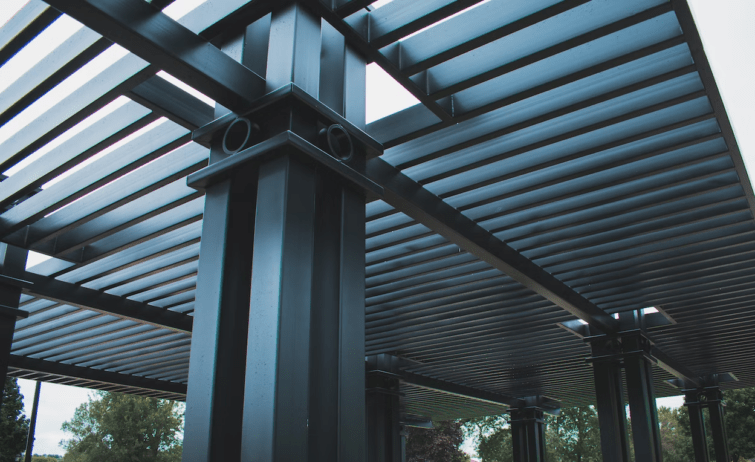
The idea of a single steel column that includes more than one part to it can be explored even further using this particular example. This particular structure uses a variety of elements to make each column stand out on its own while also being complementary to the overall structure. There are four identical steel bars that are used for a single column, and these columns are barely connected to each other – aside from one overarching steel piece near the rooftop. The specific color scheme of these steel columns also helps it to blend in better with the color scheme of the rooftop in question.
- Standard steel column

At the same time, there is nothing that says you cannot use the most basic I-shaped steel column as a part of your supporting structure. The example above also shows that it is possible for these basic columns to look just as impressive as some sort of complex architectural masterpiece. In this particular example, each and every steel column is placed the same amount of space from each other, and the color scheme that is similar to how the building itself looks makes it extremely easy for these columns to fit in with the entire structure’s composition.
- A variation of tree-like supporting steel columns

Steel columns can also support a lot more than just regular flat rooftops and building floors. This particular project from Georgia is an architectural piece of art that uses three different steel columns that are both connected to each other and spread apart to cover the entire area of the object that acts as a roof here. The connection between different columns makes the entire structure more stable and the different column placements offer more coverage and more even weight spread.
- Steel column coverage for wide areas

The aforementioned tree-like composition of steel columns makes it extremely useful not just for large buildings, but also for almost any object that needs to cover a lot of ground, such as this particular example. We can see here that the roof in question covers a lot of ground and the usage of steel columns with branches allows for the weight of the entire massive roof to be more evenly distributed for all of the supporting elements.
- A set of V-shaped steel columns
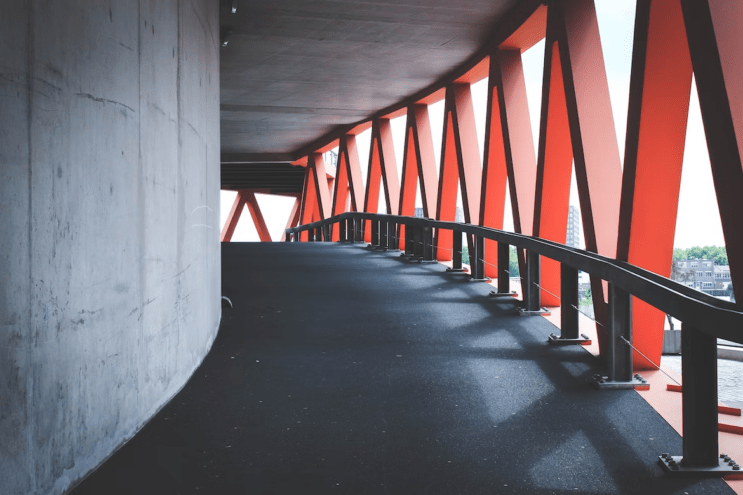
While it is true that a lot of the supporting elements tend to blend in with the environment, there are also quite a few that try to stand out more – such as this particular example of a covered walkway that has its supporting structure as a variety of V-shaped elements with their ends connected to each other. These elements are also painted bright red, which makes them hard to miss and puts more emphasis on the supporting structure as a part of the floor’s design.
Conclusion
Steel columns are structural elements that can be both irreplaceable parts of almost any building and also act as a part of its overall design, which is why there are so many different steel column types out there. We hope that this article could help people in terms of both general information about the topic of steel columns as well as to provide several different ideas for steel column designs.
- The definition of steel column
- Steel column types
- Composite steel column
- Short reinforced steel column
- Square/rectangular steel column
- Tension steel column
- T-shaped steel column
- Circular steel column
- L-shaped steel column
- Spiral steel column reinforced with concrete
- Stub steel column
- Tied steel column reinforced with concrete
- 10 steel column ideas
- Conclusion





